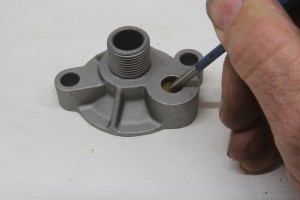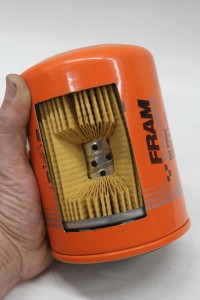I’m confused. I’ve seen magazine stories that say you should plug off that oil filter bypass in a small block Chevy but I’ve also heard that you shouldn’t do that. But with the bypass, doesn’t a bunch of oil go around the oil filter? That can’t be good, right?
S.F.
Jeff Smith: Essentially you are correct on all those assumptions except the last one. Before we get into this, let’s first examine why that bypass is there in the first place for all engines, not just Chevrolets. Oil filters create a small amount of pressure loss caused when the pump has to push the oil through the filter. While all good car people religiously change their oil, engine designers have to take into account the fact that not everybody cares about their engines like hot rodders. So for that one percent who don’t change their oil, engineers must design parts around these engine abusers. If an oil filter becomes plugged, there needs to be a safety valve or bypass that will allow the engine to pump oil – as dirty as it may be – to the rest of the engine. Dirty oil is still preferable to no oil.

This is the oil filter adapter for a small- or big-block Chevy. It only takes slight pressure to open the valve which allows oil to bypass the filter and go directly to the engine.
In the case of the small or big block Chevys, the designers built in a simple bypass valve with a small spring behind it that is rated to open at roughly 17-18 pounds of force. This valve is located on the filter adapter. It’s also important to note that all oil filters filter by pushing oil from the outside toward the inside. So, if you look at the small block Chevy adapter, the valve is designed to open anytime there is 17-18 psi more oil pressure on the outside of the filter element than on the inside. This greater pressure pushes open the little flapper valve, compressing the spring. It’s a simple design that works very well. This does not bypass all the oil, only a certain amount. The majority of the oil is filtered.
This bypass situation also occurs when the oil is cold and the thick, which increases the pressure drop across the oil filter. Once the oil reaches its normal operating temperature – roughly around 190 to 215 degrees F, this valve is probably closed or only partially open as the oil has thinned out. Of course, this will change with the type of filter you are using. A typical oil filter like the Fram Extra Guard is rated at 95 percent efficient at filtering particles down to 20 microns (0.000787-inch). Comparing that to a Fram Ultra Guard Synthetic filter with a 99-percent, 20-micron efficiency you can see that it will probably be easier to push oil through the Extra Guard filter than it will through the Ultra Guard. These percentage numbers are established with a single pass test, so the oil only went through the filter once yet it was able to remove 95 to 99 percent of all particles below 20 microns. That’s pretty good. When you have this kind of filter efficiency, you can afford to bypass a little oil to protect against damage to the filter. It’s also worth repeating a great axiom given to us by an oil filter engineer – “The best oil filter is a really good air filter.” If you think about it, it makes a lot of sense.

This is a cutaway of a Fram racing oil filter. Unfiltered oil enters the outside of the filter, pushes through the pleats in the filter and then exits through the center. Race filters use a less-restrictive filter element that increases oil flow through the filter. The trade-off is race filters do not filter as finely as regular street engine filters.
The reason you don’t want to plug this bypass is really about not creating a bigger problem. I’ve witnessed Fram’s testing of filters in their Ohio test lab and almost always the filter gasket blows out before the filter can splits. If you want a lesson in oil pressure, try this little test with an engine on an engine stand. With cold oil, kneel down until you are at eye level with the oil filter. Now, using a pressure luber like a ½-inch drill motor, spin just the oil pump to create 60-65 psi of oil pressure (engine not running). You will be shocked at how much that filter housing grows with oil pressure. That will also make you think about not revving a cold engine with cold oil like some guys like to do. That’s just not a good idea for a bunch of reasons.
Even if just the filter gasket blows out, this doesn’t make it any less of a mess. It takes mere seconds for an oil pump to push a couple of quarts of oil all over the engine compartment. Worse, you don’t want to push hot oil on a set of extremely hot headers – that’s a recipe for disaster. The flash point of oil refers to the temperature at which oil will ignite and burn. Motor oil will flash at roughly 450 degrees F. Headers routinely operate at this temperature under load, so you don’t want that to happen to you.
Generally, oil filters are so good now yet they don’t present backpressure problems once the oil is up to temperature. Of course, running a 10w30 or a 5w30 oil is also a good idea as that oil will be thinner when it’s cold, making it easier to pump through the filter. It’s all about making life a little easier for your engine.

Do not block off oil bypass. A ruptured filter introduces trash into the bearings, and can block oil veins. Resulting in expensive engine repairs/replacement.
The use of a race “high pressure” filter like a Wix race filer. no bustin filters.
Great article .. we engine guys are lucky to have people like you that can and will pass on your vast knowledge that took years of your time to discover.
Most bypass caps for a SBC are 15psi .. you stated 17 – 18psi . which is best ? using a high volume pump
Mike I don’t think it’s critical between 15 and 18 psi – this is just a way to prevent excessive pressure buildup in the filter. The application dictates use – but most of the time on a small-block Chevy for example – I don’t see a need for a high volume oil pump. Clearances getting tighter and better oil control all point to reducing volume – remember – pressure is created with a given volume pushing against a restriction. So if a standard volume pump will do the job – there are few good reasons to choose a high volume pump. With LS engines, we’re going for reduced volume pumps to keep the pressure down! Melling makes an 18 percent reduced volume pump for LS engines that I want to try.
Jeff, absolutely. reduce the output volume of the pump, reduces the power necessary to drive the pump, ergo more power to drive the wheels.
Great article Jeff however, you don’t state that most oil filters have a bypass built in so that if the oil filter gets clogged or the oil is too thick to go through the filter it will bypass thanks.
so the oil only went through the filter once yet it was able to remove 95 to 99 percent of all particles below 20 microns. That’s pretty good.
Doesn’t it should be 20 microns and above.
I think you are correct. The author needs to comment on this.
Yes you are correct – it should read 20 microns and larger.
Does anyone know if on a 1999 vortec 5.7 cadillac escalade if filtered oil enters the oil cooler? Im wondering cause im not sure if metal particles can enter the cooler?
Am I risking any damage to my engine by eliminating any oil filter adapter and putting the filter right on the block?
92 Xj in-line 6 btw
The filter screws onto the adapter, the adapter is bolted to the block, leave it out and you cannot install the filter.
Can I take off the oil filter and put a oil adpater on
Can I take off a oil filter and put on a oil adpater
Why does MSD distributor instructions recommend disabling the oil bypass?
When I started my 1995 Chevy 350 engine for the first time the oil pressure popped to 80 PSI because of a high volume pump. It then dropped like a rock to 0 PSI and I shut it off. It has a oil cooler factory tyoe as it is in a Silverado 1994. Is there some other places that would create that sudden of a loss? i CHANGED THE OIL PUMP back to a stock type and still only get about 40 PSI then drops.
Any ideas where to look? I checked for all the plugs in block and they are in, I am lost. Any Ideas??
Have oil bypass in place on a rebuild of a SBC 350. All new bearings. Started the motor and saw oil in the lifters and in the valve train but the gasket on the filter blew out. Replaced filter and gasket blew out within 2 seconds of motor starting. New oil pump, but does not mean it is working correctly. If the bypass in the pump itself is not working would this cause too much oil pressure in the filter and cause the gaskets to blow out?
I think in normal use a oil filter is plugged completely by the time it gets 3K miles on it. If you look at the rate of darkening of your motor oil it is not at linear rate. on my 4.0L jeep i run a wix 51773 which is roughly 3 times larger than the OEM filter. after 2K miles i change the filter and top off the oil, after another 2K i change it again. It is amazing at just how clean the oil stays in my jeep. I have went as far as as 15K like this before a complete oil change.
The oil will still appear clean, but what you want to keep an eye on is the oils viscosity and lubrication properties. In other words how the oil feels when you pinch it and rub it between your fingers. And how much pressure you can apply while rubbing it before it looses it’s ability to still keep your fingers from easily sliding.
Great article just did a small build on a 355 and only get 5 pounds at idle and jumps a little after that this is on my 1989 k1500 every oil plug is in using Melling high volume pump and was wondering if the bypass had anything to do with this going crazy trying to figure this out. All clearances r correct
What are your thoughts on running no bypass, but a giant filter like a Wix 51794 or Fram PH 373? Would the extra surface area of the filter media keep internal filter pressure low enough to stop gasket or filter housing failure?